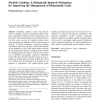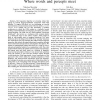302 search results - page 44 / 61 » Robot Assisted Standing-Up |
COGCOM
2010
13 years 5 months ago
2010
Controlling cognitive systems like domestic robots or intelligent assistive environments requires striking an appropriate balance between responsiveness and persistence. Basic goal...
DAGM
2010
Springer
13 years 4 months ago
2010
Springer
We present a model-driven approach to the segmentation of nasal cavity and paranasal sinus boundaries. Based on computed tomography data of a patients head, our approach aims to ex...
ECTEL
2008
Springer
13 years 9 months ago
2008
Springer
Modeling the cognitive processes of learners is fundamental to build educational software that are autonomous and that can provide highly tailored assistance during learning [3]. F...
IROS
2006
IEEE
14 years 1 months ago
2006
IEEE
— Our long-term objective is to develop robots that engage in natural language-mediated cooperative tasks with humans. To support this goal, we are developing an amodal represent...
ICRA
2009
IEEE
14 years 2 months ago
2009
IEEE
—Unstructured, human environments present great challenges and opportunities for robotic manipulation and grasping. Robots that reliably grasp household objects with unknown or u...


